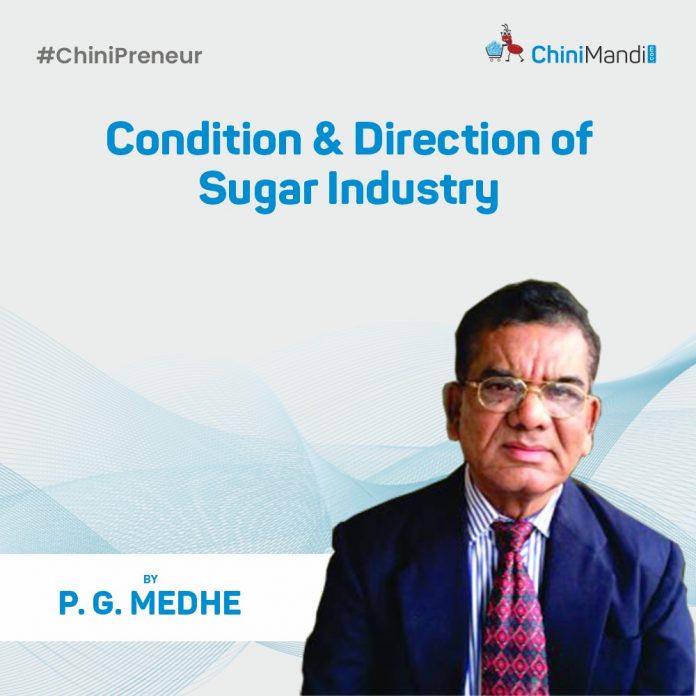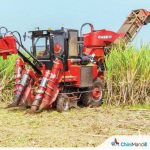In the backdrop of evolving economic landscapes and fluctuating market dynamics, the sustainability and competitiveness of cooperative sugar factories have come under scrutiny. As pillars of rural economies, these entities play a pivotal role in fostering agricultural growth, generating employment, and contributing to national GDP. However, amidst the myriad challenges confronting the sugar industry, one issue stands out as paramount: the burgeoning wage bill.
Recently all the Managing Directors of the Sugar Factories around the Kolhapur District had a brainstorming session on the issues suffered during the sugar season 2023-24 and what will be the challenges for the ensuing sugar season 2024-25. While discussing the total conversion cost per ton of sugar cane crushed, it is found that “ Salaries and Wages” cost of the cooperative sugar factories ranges from ₹300 to ₹350 per ton of cane crushed during the season 2023-24 which requires it to be reduced.
The wage bill, encompassing salaries, benefits, and associated expenses, represents a significant portion of the operational costs for cooperative sugar factories. While fair compensation is essential for a motivated workforce and social equity, unchecked escalation in labor expenses poses grave threats to the financial viability and long-term viability of these institutions.
This article aims to delve into the pressing need for a concerted effort towards reducing the wage bill of cooperative sugar factories. By exploring the underlying factors driving the upward trajectory of labor costs and delineating potential strategies for mitigation, it endeavors to chart a course towards sustainable economic stewardship and organizational resilience.
From macroeconomic trends to micro-level operational challenges, the narrative traverses the multifaceted landscape of labor dynamics within cooperative sugar factories. Drawing upon empirical evidence, industry insights, and expert perspectives, it elucidates the implications of an inflated wage bill on profitability, competitiveness, and stakeholder welfare.
Furthermore, the article endeavors to foster dialogue and collaboration among stakeholders—management, labor unions, policymakers, and community representatives—towards devising pragmatic solutions. Through proactive engagement and collective action, it advocates for a paradigm shift in labor management practices, rooted in efficiency, fairness, and shared prosperity.
In essence, this article serves as a clarion call for introspection and action—a rallying cry for the recalibration of labor-cost dynamics within cooperative sugar factories. By embracing innovation, collaboration, and strategic foresight, the industry can navigate the winds of change and emerge stronger, more resilient, and better equipped to fulfill its socioeconomic mandate in the decades to come.
Here are some of the remedies to be thought over for the reduction of wage-bill especially of the cooperative sugar factories.
(A) OFF SEASON WORK WITH THE PERMANENT STAFF GIVING BRAKE TO SEASONAL STAFF
The sugar industry indeed operates on a seasonal basis, with peak activity during harvesting and processing seasons. During off-season periods, such as planting or maintenance, the workload decreases substantially. To manage costs efficiently, sugar factories often retain a core group of permanent staff for year-round operations. These permanent employees possess the necessary skills and experience to ensure the smooth functioning of the factory even during off-peak periods.
During the off-season, it’s essential to minimise expenses to maintain profitability. Calling in only the permanent staff allows the factory to control wage expenditure, as these employees are typically on fixed salaries or have contractual agreements that ensure their availability throughout the year. This approach helps to avoid unnecessary costs associated with hiring temporary workers, such as recruitment, training, and potentially higher wages due to seasonal demand.
Additionally, permanent staff are familiar with the factory’s operations, machinery, and safety protocols, which reduces the risk of accidents or errors during off-season tasks. They can efficiently perform maintenance, repairs, and other essential activities without the need for extensive supervision or additional training.
However, it’s crucial for sugar factories to balance cost-saving measures with operational requirements. If there’s a significant workload during the off-season that cannot be managed by the permanent staff alone, the factory may need to consider alternatives, such as offering overtime to existing employees or hiring temporary workers on a short-term basis.
Overall, leveraging permanent staff for off-season work in the sugar industry is a strategic approach to cost management, ensuring operational continuity while minimizing expenses ON WAGE BILL during periods of reduced activity.
(B). QUALIFIED AND COMPETITIVE STAFF SELECTION: Ensuing a qualified and competitive selection process for employees and managerial staff is essential for enhancing productivity while also optimizing the workforce. By recruiting individuals with the right skills and expertise, cooperative sugar factories can maximize efficiency, reduce operational costs, and achieve sustainable growth in the long run. This approach promotes a dynamic and skilled workforce capable of driving innovation and adapting to evolving industry demands.
(C) PREPARATION OF ANNUAL MONTH-WSE, DEPARTMENT-WISE CALENDAR: This calendar provides a comprehensive overview of the factory’s planned activities, broken down by department and month. It includes key tasks, projects, maintenance schedules, and any other relevant activities.
By mapping out the entire year in advance, the factory can anticipate busy periods and plan staffing accordingly, thereby minimizing the need for excess manpower during slower months.
It allows for better resource allocation, ensuring that employees are deployed efficiently and tasks are completed on time. Additionally, it enables the identification of potential bottlenecks or conflicts in schedules, allowing for proactive solutions to be implemented.
1) Timely Completion of Work with Minimum Workforce: With the annual calendar in place, the factory can optimize its workflow to achieve timely completion of tasks with the least number of employees necessary. By scheduling tasks strategically and prioritizing high-impact activities, the factory can minimize downtime and maximize productivity.
This approach reduces the need for overtime or temporary workers, saving on labor costs.
It also improves employee morale and satisfaction by promoting a more manageable workload and better work-life balance.
2) Twice-Monthly Coordination Meetings of Department Heads: These meetings serve as a forum for department heads to discuss progress, challenges, and upcoming priorities. They facilitate coordination and collaboration between departments, ensuring that everyone is aligned with the overall goals and objectives of the factory. By addressing issues proactively and sharing best practices, these meetings help to streamline operations and eliminate inefficiencies.
Follow-up actions from previous meetings are tracked and discussed, holding each department accountable for their commitments and ensuring that tasks are completed on schedule.
Regular communication among department heads also fosters a culture of teamwork and mutual support, leading to greater overall effectiveness and productivity.
In summary, the combination of an annual month-wise department-wise calendar and regular coordination meetings among department heads enables the cooperative sugar factory to optimize its operations, minimize labor costs, and enhance overall efficiency. This proactive approach not only benefits the bottom line but also contributes to a more cohesive and high-performing organization.
(D) TIME AND MOTION STUDIES :
Time and motion studies are critical tools for improving efficiency and productivity in cooperative sugar factories. By analyzing and optimizing the way tasks are performed in each department, these studies can help reduce the wage bill in several ways:
1) Identifying inefficiencies: Time and motion studies involve carefully observing and documenting how tasks are completed. By doing so, inefficiencies, such as unnecessary movements or redundant processes, can be identified and eliminated. This streamlining of operations can lead to time savings, allowing the same amount of work to be completed with fewer labor hours.
2) Optimizing workflows: Through time and motion studies, workflows within each department can be analyzed and optimized for maximum efficiency. This may involve rearranging workstations, revising procedures, or implementing new technologies to streamline processes. By reducing the time it takes to complete tasks, labor costs can be minimized without sacrificing productivity.
3) Standardizing procedures: Time and motion studies can help establish standard operating procedures (SOPs) for each task within the cooperative sugar factory. Standardization ensures that all workers perform their duties in the most efficient manner possible, minimizing variation in performance and ensuring consistent productivity levels across departments.
4) Training and skill development: By closely observing how tasks are performed, time and motion studies can identify areas where workers may benefit from additional training or skill development. Investing in training programs can improve employee proficiency and effectiveness, leading to higher productivity and lower labor costs over time.
5) Equipment utilization: Time and motion studies also evaluate the utilization of equipment and machinery within the cooperative sugar factory. By identifying underutilized or inefficiently used equipment, adjustments can be made to improve overall productivity. This may involve implementing preventive maintenance schedules, upgrading outdated machinery, or reallocating resources to better match demand.
Overall, time and motion studies play a crucial role in optimizing the efficiency of cooperative sugar factories, leading to reduced labor costs while maintaining or even increasing productivity levels. By continuously monitoring and improving processes across all departments, these studies help ensure the long-term sustainability and profitability of the factory.
(E) DRAFTING SOPs OF ALL THE DEPARTMENTS
Drafting SOPs for a cooperative sugar factory to enhance timely performance and reduce workforce and wage bills requires a comprehensive approach. Here’s a framework to consider:
1) Performance Metrics Definition: Clearly define key performance indicators (KPIs) for each department or role, focusing on productivity, efficiency, and quality. Examples include sugarcane processing rate, sugar extraction efficiency, maintenance downtime, and product quality standards.
2) Responsibilities and Accountability : Assign specific responsibilities to each employee based on their role and expertise. Clearly outline reporting structures and lines of authority to ensure accountability.
3) Training and Development: Provide regular training sessions to enhance skills and knowledge relevant to employees’ roles. Invest in cross-training to ensure flexibility and resilience within the workforce.
4) Process Optimization: Analyze existing workflows and identify areas for improvement to streamline operations and reduce inefficiencies. Encourage employees to suggest process enhancements and implement a system for evaluating and implementing these suggestions.
5) Resource Management: Optimize resource allocation, including human resources, equipment, and raw materials, to minimize waste and maximize output. Implement a system for tracking resource usage and identifying opportunities for cost-saving measures.
6) Performance Reviews and Incentives: Conduct regular performance reviews based on established KPIs, providing feedback and recognition for achievements. Implement incentive programs tied to performance targets to motivate employees and reward high performers.
7) Communication and Transparency:Foster open communication channels between management and employees to ensure everyone is aligned with organizational goals and objectives.
Provide regular updates on performance metrics, targets, and progress towards goals.
8) Continuous Improvement Culture: Cultivate a culture of continuous improvement, encouraging employees to identify areas for enhancement and participate in problem-solving initiatives.
Implement regular review cycles to assess the effectiveness of SOPs and make adjustments as needed.
9) Compliance and Safety: Ensure all operations adhere to relevant regulations and safety standards to protect employees and maintain operational integrity.Provide ongoing training and resources to promote a safe working environment.
10) Documentation and Review: Document all SOPs and regularly review them to ensure they remain relevant and effective.Incorporate feedback from employees and stakeholders to refine and improve SOPs over time.
By implementing these SOPs and fostering a culture of accountability, efficiency, and continuous improvement, the cooperative sugar factory can enhance timely performance, reduce workforce, and optimize wage bills.
(F) IMPLEMENTATION OF VOLUNTARY RETIREMENT SCHEME:
Implementing voluntary retirement schemes (VRS) in cooperative sugar factories can be a strategic approach to reduce excess staff and, consequently, the wage bill. Here’s a detailed exploration of the implementation process and its potential benefits:
1)Assessment of Staffing Needs: Before initiating a VRS, it’s essential to conduct a comprehensive assessment of staffing requirements. This involves analyzing current workforce levels, skill gaps, production demands, and future projections. Identifying areas of redundancy or inefficiency helps tailor the VRS to target specific departments or job roles.
2) Designing the VRS Package: The success of a VRS hinges on the attractiveness of the retirement package offered to employees. Factors to consider include financial incentives, such as lump-sum payments or pension enhancements, healthcare benefits, and counseling services. The package should strike a balance between incentivizing voluntary retirement and mitigating financial strain on the organization.
3) Communication and Consultation: Transparent communication and stakeholder consultation are paramount to the success of a VRS. Management should engage with employees, labor unions, and other relevant stakeholders to explain the rationale behind the scheme, address concerns, and solicit feedback. Clarity regarding eligibility criteria, entitlements, and timelines fosters trust and facilitates informed decision-making.
4) Voluntary Participation and Consent: Participation in the VRS should be entirely voluntary, without coercion or undue pressure. Employees should be provided with adequate time to consider their options, seek advice if needed, and make informed decisions based on their individual circumstances. Confidentiality should be maintained throughout the process to respect the privacy of participants.
5) Implementation and Transition Planning: Once the VRS is approved, meticulous planning is essential for seamless implementation and transition. This includes establishing clear timelines, coordinating administrative procedures for exit formalities, redistributing workload or restructuring teams as necessary, and providing support to remaining staff members to mitigate disruptions.
6) Monitoring and Evaluation: Continuous monitoring and evaluation are essential to gauge the effectiveness and impact of the VRS. Key performance indicators such as staff reduction targets, cost savings, productivity levels, and employee morale should be tracked over time. Feedback mechanisms enable adjustments to be made as needed to optimize outcomes and address any unforeseen challenges.
7) Mitigating Social Impact : Recognizing the potential social implications of workforce reduction, particularly in rural communities dependent on sugar factories for livelihoods, measures should be taken to mitigate adverse effects. This may involve offering retraining programs, facilitating job placement assistance, or supporting entrepreneurship initiatives to empower affected individuals to pursue alternative livelihoods.
By implementing a well-designed VRS in cooperative sugar factories, excess staff can be reduced in a manner that is fair, voluntary, and mutually beneficial. Not only does this contribute to cost savings and improved operational efficiency, but it also lays the foundation for a more agile and sustainable workforce aligned with the evolving needs of the industry.
(G) TIMELY SUPPLIES OF STORES MATERIAL REQUIRED DURING OFF SEASON
Timely supply of spare parts, oil, lubricants, welding materials, steel, chemicals, and other manufacturing items during the off-season is crucial for the smooth operation of a sugar factory. Let’s break down why each of these supplies is important:
1) Spare Parts: Machines and equipment in a sugar factory are subject to wear and tear. Having spare parts readily available ensures that any breakdowns can be quickly addressed, minimizing downtime and preventing delays in production.
2) Oil and Lubricants: Proper lubrication is essential for the efficient functioning of machinery. Regular maintenance with the right oils and lubricants helps prevent friction, reduces wear on moving parts, and extends the lifespan of equipment.
3) Welding Material: Welding is often needed for repairing or fabricating metal structures and components. Having a sufficient supply of welding materials allows for prompt repairs and modifications, ensuring that operations can continue smoothly.
4) Steel: Steel is a primary material used in the construction and maintenance of infrastructure within the sugar factory, including machinery, storage tanks, and pipelines. Adequate stocks of steel ensure that any structural repairs or expansions can be carried out without delays.
5) Chemicals: Various chemicals are used in the sugar production process, such as cleaning agents, water treatment chemicals, and additives for refining. Maintaining a consistent supply of these chemicals is essential for maintaining product quality and meeting regulatory standards.
6) Manufacturing Items: This category encompasses a wide range of items necessary for day-to-day operations, such as tools, safety equipment, packaging materials, and maintenance supplies. Ensuring a steady supply of these items helps prevent disruptions and keeps the factory running efficiently.
By ensuring timely supply of these essential materials during the off-season, the sugar factory can complete planned maintenance and upgrades without delays. This proactive approach helps avoid overtime expenses, reduces the need for extra workforce, and ultimately lowers the overall wage bill. Additionally, minimizing downtime during the off-season maximizes the factory’s productivity and profitability in the long run.
By sending a message, you agree to our Terms. Read our Privacy Policy. Don’t share sensitive info. Chats may be reviewed and used to train our models. Learn about your choices.
(H) IMPLEMENTATION OF SCIENTIFIC MATERIAL INSPECTION METHODS :
Implementing scientific material inspection methods is crucial for ensuring the quality and suitability of newly purchased materials for use in a sugar factory, both during the off-season and the crushing season. Here’s a detailed exploration of some effective inspection methods:
1) Visual Inspection: This is the most basic form of inspection where materials are visually examined for any defects, damage, or inconsistencies in quality. Trained inspectors can identify issues such as surface imperfections, dimensional irregularities, and improper labeling.
2) Dimensional Measurement: Utilizing precision measuring tools such as calipers, micrometers, and gauges, inspectors can verify the dimensions of critical components to ensure they meet specifications. This is particularly important for parts that need to fit precisely within existing machinery or structures.
3) Material Composition Analysis: Techniques such as spectroscopy, chromatography, and microscopy can be used to analyze the chemical composition and material properties of samples. This helps confirm that materials meet required standards and are suitable for the intended application.
4) Non-Destructive Testing (NDT): NDT methods, including ultrasonic testing, radiography, magnetic particle testing, and dye penetrant testing, allow inspectors to assess the integrity of materials without causing damage. These methods are especially useful for detecting hidden defects or flaws that could compromise performance or safety.
5) Mechanical Testing : Mechanical properties such as strength, hardness, ductility, and toughness can be evaluated through standardized tests such as tensile testing, hardness testing, impact testing, and fatigue testing. These tests help ensure that materials can withstand the stresses and conditions they will encounter during operation.
6) Quality Management Systems (QMS) : Implementing QMS standards such as ISO 9001 can help establish rigorous processes for material inspection and approval. This includes documenting procedures, conducting regular audits, and maintaining records to ensure consistent quality control throughout the supply chain.
2)Supplier Audits: Periodic audits of material suppliers can provide valuable insights into their manufacturing processes, quality control measures, and compliance with regulatory requirements. By selecting reputable suppliers and maintaining open communication, the risk of receiving substandard materials can be minimized.
By employing a combination of these scientific material inspection methods, sugar factories can effectively evaluate the quality and suitability of newly purchased materials, whether during the off-season or the crushing season. This proactive approach helps prevent downtime, minimize the need for extra workforce and overtime, and ensures smooth and efficient operation of the factory.
(I) DIGITISATION OF ALL THE DEPARTMENTS:
Digitization of all departments of a cooperative sugar factory can indeed lead to significant reductions in staff requirements and, consequently, in the wage bill. Here’s a detailed exploration:
1) Automation of Processes: Implementing digital systems and automation technologies can streamline various processes across departments such as production, inventory management, quality control, and distribution. This reduces the need for manual intervention and consequently decreases the requirement for a large workforce.
2) Data Management Systems: Introducing digital data management systems enables efficient storage, retrieval, and analysis of data related to production, sales, finance, and human resources. This facilitates informed decision-making and reduces the need for personnel dedicated solely to data handling tasks.
3) Remote Monitoring and Control: With the help of IoT (Internet of Things) devices and sensors, critical equipment and processes can be monitored and controlled remotely. This minimizes the need for on-site personnel for supervision and maintenance.
4) Employee Self-Service Portals: Implementing self-service portals for employees can automate various HR tasks such as leave management, attendance tracking, and payroll processing. This reduces the administrative burden on HR staff, allowing them to focus on more strategic functions.
6) Supply Chain Integration: Digitizing supply chain processes through tools like ERP (Enterprise Resource Planning) systems enables seamless coordination between different stakeholders including suppliers, manufacturers, and distributors. This improves efficiency and reduces the need for manual oversight.
7) Customer Relationship Management (CRM): Utilizing CRM software allows for effective management of customer interactions and sales pipelines. This can lead to better customer satisfaction and retention, ultimately contributing to increased revenue without proportionately increasing staff.
8) Training and Skill Development: Investing in digital training programs for existing staff can enhance their skills and adaptability to the new digital environment. This ensures that the workforce remains productive and efficient even with a reduced headcount.
9) Cost Savings and Efficiency Gains: Overall, digitization leads to cost savings through improved efficiency, reduced errors, and optimized resource utilization. These savings can directly translate into a reduction in the wage bill while maintaining or even improving productivity levels.
However, it’s essential to note that while digitization can significantly reduce staffing requirements, it’s crucial to manage the transition effectively to minimize disruptions and ensure that the remaining workforce is adequately trained and equipped to handle the digital tools and processes. Additionally, considerations for data security, regulatory compliance, and ongoing technological advancements should also be taken into account during the digitization process.
CONCLUSION: In conclusion, the imperative for reducing the wage bill of cooperative sugar factories is clear, given the evolving economic landscape and the need for greater efficiency and competitiveness. Embracing digitization presents a promising avenue for achieving this goal by streamlining processes, optimizing resource utilization, and enhancing overall productivity. While the transition to a leaner workforce may pose challenges, the potential benefits in terms of cost savings, improved operational effectiveness, and long-term sustainability make it a strategic imperative for cooperative sugar factories to embrace the digital transformation journey. By leveraging technology and empowering their workforce with the necessary skills, these factories can navigate the changing dynamics of the industry and emerge stronger and more resilient in the face of future challenges.
Mr. P.G. Medhe is the former Managing Director of Shri Chhatrapati Rajaram Sahakari Sakhar Karkhana Ltd and sugar industry analyst. He can be contacted at +91 9822329898.












